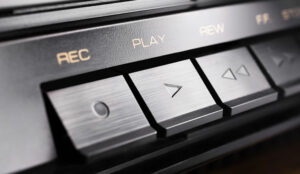We asked our panel about the key features to look out for when purchasing a call recording solution.
The flexibility to search by agent ID in a free-seating environment
Increasingly, one of the key features customers are asking for within their call recording system is advanced ‘search ability’.
Organisations are asking for ever more complex ways to search for and find their recordings.
It’s no longer good enough to be able to search by extension, date and time, contact centres want the flexibility to do things like search by agent ID in a free-seating environment.
When asking your supplier about voice recording, it’s generally a good idea to find out if the proposed solution can integrate into your telephony or switch at the required level to provide this type of flexibility – and can then support that integration on an ongoing basis.
Giving access to the right people
Call recordings can contain sensitive information and thought must go into who you want to have access to the recordings and who you want to entrust with managing and administering recordings.
You should also look for systems which can easily be configured to allow your agents access to their own calls, so that they can self-evaluate and focus on areas for improvement.
Your supplier needs to be able to configure the call recording system in the way you want it to work for you, defining user privileges that meet your business requirements.
This also should take into consideration any compliance regulations which need to be met and any internal risk management protocols the organisation has in place.
Complex systems need extra levels of support
It’s important to remember that call recording applications are technical systems and some manufacturers are not always geared up for support, and may place more emphasis and resource on product development, which is understandable.
Similarly, when buying call recorders from telephony providers, they are generally only able to provide first-line support and typically may need to refer issues back to manufacturers – leading to delays in response times and fixes.
Call recording systems and their ancillary applications can be deceptively complex and it is worth taking the time to ensure you get competent support that matches the operational needs of the business.
Think about your contact centre opening hours (for example, do you work over the weekends?), then get support to match your business hours.
If you want your supplier to be able to remotely access and resolve issues for quicker problem resolution, then shop around to see who can provide flexible and varying levels of support contracts.
Double check that you’ll have access to older recordings too
Some industries have to retain call recordings for a number of years depending on the regulation in that particular sector, the insurance industry for one.

Tim Thurston
So when investing in a new call recording system, always ask how you can easily access recordings from older legacy systems alongside more recent recordings should the regulator demand it.
There are products out there which act as a portal, providing a single user interface to find and play back calls across multiple recording systems, old and new, on-site and off-site.
This type of technology can help contact centres greatly reduce the costs of maintaining older systems alongside their newer call recording investments.
With thanks to Tim Thurston at Business Systems (UK) Ltd
The ability to stream and download recordings is essential
The call recording interface must allow you to archive, query and locate individual call recordings (or batches of recordings) from a large database.
The ability to stream and download recordings is also essential. An intuitive interface and effective search facility means less time spent resolving issues and greater efficiency for your agents, team leaders and call centre managers.
Your interface should only be accessible by nominated and authorised staff
For data protection reasons, security is a critical feature of any call recording solution.
Businesses should ensure that their call recording interface is only accessible by the nominated and authorised staff.
If this is via an external website, this should be hosted on a secure site using SSL and should include password-protected user accounts.
With thanks to Martyn King at Nexbridge
Ensure minimal loss even when a disaster occurs
The recording should be aligned with the PBX’s geo-redundancy structure in order to ensure a minimal loss even when a disaster occurs.
Recording is a mission-critical system, so every component should be fully redundant.
Your system must support flexible data retention rules
In different sectors, different types of data should be kept stored for different periods of time.
When regulations are getting more complex, your recording system must support flexible data retention rules for deleting customer interactions only when the law allows it.
Prepare for the next generation of applications with real-time readiness
Your recording system is not just for recording. It is also the main platform on which you build business applications that are able to extract value from the stored interactions, including:
- Analysing customer voiceprint for authentication and fraud prevention.
- Analysing interaction content during the conversation and notifying supervisors when agents are in need of assistance.
- Locating sales opportunities during the interactions and guiding the agents to successful sale completion.
In order to make sure your contact centre is ready for the next generation of business applications, your “recording” system must support real-time streaming with minimal latency, but should do it without dramatically increasing the total cost of ownership.
Store all recordings from all channels in a single recording platform

Zviki Ben-Ishay
Your customers do not just interact with you through the voice channel.
As more and more channels arise (including video, chat and email), it is highly important for all of them to be stored in a single recording platform.
This will ensure regulatory adherence and standardised workforce optimisation processes across multiple channels.
With thanks to Zviki Ben-Ishay at NICE Systems
Software-based recording can process up to 100% of your interactions
Software-based recording can capture, index and retrieve up to 100% of your customer/caller interactions across IP, traditional and mixed telephony environments.
This makes accessing recordings for training, quality or compliance reasons significantly easier, saving valuable time and increasing operational effectiveness.
It also enables a more agile recording approach, supporting home-based agents or remote offices in addition to traditional contact centre or support centre recording.
In addition to recording conversations between customers and agents, some recording solutions can also capture the corresponding activities taking place at agents’ desktops – such as keystrokes, data entry, screen navigation, and after-call wrap-up.
Select a solution that works with other workforce optimisation tools
Selecting a recording solution that works with other workforce optimisation tools can help contact centres go beyond full-time recording and compliance recording.
By incorporating tools such as speech analytics, text analytics, customer surveys and other enterprise feedback approaches, customer engagement teams can gain much greater insight into interactions and sentiments.
This can lead to making better, more strategic decisions that can have a direct impact on costs, revenues, customer satisfaction and competitive advantage.
Have monitoring checks in place to ensure recording takes place

Steve Chaplin
For compliance recording, it’s important to have the right monitoring checks in place that look beyond high-level system availability metrics and make sure that recording is actually taking place.
Should calls not be recorded for any reason, automatic notification needs to happen immediately – along with a snapshot of the environment at the time recording stopped to prevent any future recurrence.
With thanks to Steve Chaplin at Sabio
The architecture matters if you need to support dispersed organisations
If you are recording a single agent group at a single location then the capture process is simple. More complex operating environments need the assurance that the call recorder supports multiple recording architectures.
These technical considerations have real business implications.
In short, the architecture matters if you are to ensure that you have the right tools to support dispersed organisations with many customer touch points and high customer experience expectations.
Make sure there is encryption for “data in transit” – not just “data at rest”
There are specific components of customer interaction which should never be recorded. The requirements of PCI DSS are now clear and the recorder must be able to support your compliance.
But for those calls that you do wish to record, you need to store each transaction securely, to protect private data and to meet mandatory security regulations and recommended guidelines. No ifs and no buts.
So that means encryption before calls are transmitted over the network to the storage device, and encryption while stored.
So that’s encryption for “data in transit” and not just “data at rest”. Access is by authorised users only.
And recordings should be compressed before they’re sent to the designated storage device. It’s all about having the right tools for the job!
Hyperlink access into CRM records is a useful retrieval tool
Finding the needle in the haystack! How many thousands of calls are you likely to record every month and for how long will you want to keep them?
The numbers quickly build – so insist on easy navigation and metadata tags to make sure you can find a particular call when you need it.

Neil Griffiths
Archive Search should allow you to locate specific calls or groups of calls based on combinations of employee, agent, date, time, phone number and user-defined fields. Hyperlink access into CRM records is another useful retrieval tool.
A modern Web 2.0 interface will go a long way towards ensuring that your recorder is simple to deploy, learn and use so that your staff, whether in the call centre or in the back office, have the right tools to access the recordings they need.
With thanks to Neil Griffiths at Calabrio
Data should be easily exportable to use in other applications
Calls and metadata should be easily exportable to use in other applications, such as analytics, CRM or e-learning. This means bulk export of all calls.
The world of predictive analytics means that calls are a critical data source for your business. So make sure that you can access them and use them in any way you want – don’t accept any solution that limits your ability to do this!
The ability to record all calls in stereo
The ability to record all calls in stereo is critical if you want to analyse what your customers are saying.
The ability to record cradle to grave so complete call chains can be replayed
The ability to record cradle to grave – transfer data should be tracked and stored so complete call chains can be replayed.
Call metadata should store customer identifiers
Call metadata should store customer identifiers, not just basic telephony/CTI data.
The ability to use your data in any business application you deploy
If you need encryption, consider specialist open encryption software, as this will allow you to use your data in any business application you deploy.
Only deploy proprietary encryption if you can easily export/de-crypt your calls.
Establish your real business requirements before acquiring a new recorder
There are now a large number of applications that utilise the call recordings – and the recording vendors have developed Workforce Optimisation (WFO) Suites – but establish what your real business requirements are before acquiring a new recorder.
A technology feature wish-list won’t deliver business value. Work out what you want from a call recorder and then look at the market offerings.
With thanks to Jonathan Wax at Nexidia
Opt for ‘Keypad payment by phone’ over ‘Pause and Resume’
You should make sure that your call recordings are PCI DSS compliant by using ‘keypad payment by phone’ technology for the customer’s use – preferably using an integrated provider for your call recording service and PCI-compliant phone payment technology.
While ‘pause and resume’ technology is offered as a solution, it is not the best way to make your call recordings PCI compliant. This is because it still leaves the agent/homeworker/outsourcer with access to the sensitive card data.
With touchtone (DTMF) technology conveying the PAN and CV2 however, the card data bypasses the agent and call recordings altogether, leaving your agents free to service/sell and ensuring your call recordings are full length for quality monitoring and compliance needs.
With thanks to Simon Beeching at Syntec
Find hidden business opportunities with Speech Analytics
Huge business opportunities are hidden within the thousands of conversations you have with your customers every day – and Speech Analytics helps you find them!
For a quick and easy deployment, you can take advantage of Cloud-based Speech Analytics solutions.
These will ensure your customer’s voice is heard by analysing 100% of interactions, providing actionable “Big Data” analytics that allow you to quickly understand a number of compelling business factors, as well as keep an eye on compliance.
Speech-to-Phrase Recognition can help you monitor complaints

Stefan Captijn
Within Speech Analytics, “Speech-to-Phrase” recognition is an invaluable addition to any call recording capability.
This technology directly recognises and enables you to highlight entire phrases within conversations, meaning you can monitor what people are calling your company about – including complaints – making it easier for you to decide what changes your company can make to improve customer service.
The technology enables you to:
- Discover customer satisfaction trends and problems
- Optimise agent performance and training
- Monitor compliance in regulated communications
With thanks to Stefan Captijn at Genesys
Retrieving every interaction can improve training and performance
Being able to store and retrieve every customer interaction is especially important when it comes to how we train agents, improve performance, and deliver the best customer service.
It’s also how we maintain compliance and resolve issues quickly and efficiently.
Recordings should remain confidential – even when being transferred
Even if your calls do not contain sensitive card data, keeping them confidential may be important.
However, particularly with a hosted call recording system, data needs to be transferred and stored, which inevitably presents a security risk.
One solution is to create your own in-house implementation, but this demands significant capital expenditure, as well as time and expertise. Even then, your data is only as secure as your network.
Ideally, you should expect:
- Recordings to be stored on a dedicated server
- The server to reside in a private network, behind a firewall that restricts access
- The option of call encryption
All of your recordings should be simple to retrieve
Your calls can be PCI DSS compliant. They can be stored securely on a server that’s protected on all sides. But if recordings aren’t easily available whenever you need them, none of that matters.

Chris Key
A hosted call recording solution will allow access to recordings wherever you can get online – from your laptop, tablet, or smartphone.
Check the interface you’ll be using in advance, ensuring that you can easily search, filter and browse recordings.
So when your call recording is up and running, you can spend your time reaping the benefits – not searching the archives.
With thanks to Chris Key at Hostcomm
A full suite of quality management tools will support agent coaching
Any call recording system should feature a full suite of quality management tools.
The coaching tools available to trainers and supervisors have grown in number and sophistication, with many of them offering advanced features such as automated e-learning sessions based on an individual’s performance, as well as benefits such as free seating.

David Ford
Look for a system that offers automated surveys as part of the package
Customer feedback surveys are often the missing link in the quality management chain.
You should look for a call recording system that offers automated surveys as part of the overall package rather than an expensive add-on.
With thanks to David Ford at Magnetic North
What do you think are the most important features of a call recording system?
Author: Megan Jones
Published On: 13th Aug 2014 - Last modified: 12th Nov 2024
Read more about - Technology, Business Systems, Calabrio, Call Recording, David Ford, Genesys, Hostcomm, Intrado, Nexbridge, Nexidia, NICE, Sabio, Syntec






































